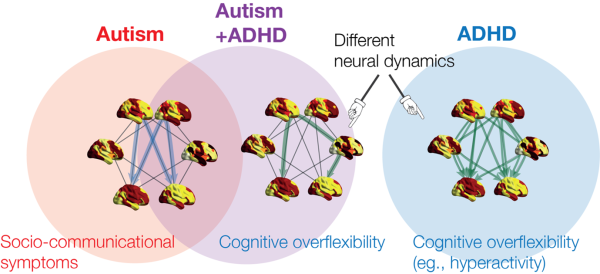—The ADHD traits in autism+ADHD comorbid condition are governed by unique neural mechanisms unseen in pure ADHD—l
Children with autism spectrum disorder (ASD) have cognitive rigidity and tend to persist in specific thoughts, whereas those with ADHD exhibit overly flexible cognition and trouble concentrating.
Despite such contrast, clinically, the two neurodevelopmental disorders are often reported to co-exist in one person. Recent updates of the widely-used diagnosis systems allowed such co-occurrence.
How can such a co-occurrence happen? Is such an ASD+ADHD comorbid condition equivalent to simply adding the two prevalent neurodevelopmental conditions?
In new work published in eNeuro, Mr. Daichi Watanabe, a then-intern student at The University of Tokyo International Research Center for Neurointelligence (UTokyo, WPI-IRCN; currently, an undergraduate student at University of California Berkely), and Associate Professor Takamitsu Watanabe at UTokyo WPI-IRCN have addressed this question: in short, the ASD+ADHD condition is not equivalent to a merger of pure ASD and pure ADHD but a subtype of ASD with unique brain dynamics that underpin its ADHD-like cognitive overflexibility (Figure. 1).
In this study, using two original data-driven approaches, the IRCN researchers analyzed resting-state brain activity datasets obtained from 338 children. The analyses revealed that the ASD-like socio-communicational symptoms of the ASD+ADHD condition are attributable to the same neural rigidity (i.e., overly stable whole-brain neural activity). In contrast, its ADHD-like traits are not governed by the neural mechanisms seen in the pure ADHD condition.
In particular, the researchers found that the different brain regions induce seemingly the same ADHD-like behaviors in the ASD+ADHD children and pure ADHD children. In the ASD+ADHD group, the unstable neural activity of the prefrontal area is the trigger of the whole-brain over-flexible neural activity, whereas the parietal area is such a trigger in the pure ADHD group.
These studies indicate that the comorbidity of ASD and ADHD is not a simple overlap of the two conditions and suggest that the condition would need a bespoke diagnosis and treatment.

Reference
Watanabe, D. & Watanabe, T. Distinct frontoparietal brain dynamics underlying the co-occurrence of autism and ADHD. eNeuro (2023) doi:10.1523/ENEURO.0146-23.2023.


